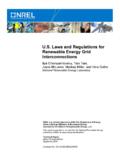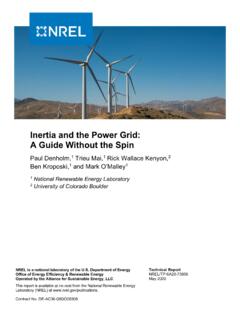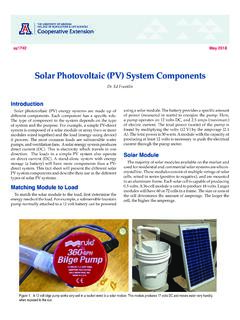Transcription of Electric Distribution System Planning with DERs High-level ...
1 PNNL-28138 Electric Distribution System Planning with DERs High-level Assessment of Tools and Methods March 2020 JS Homer D Narang Y Tang M Coddington JD Taft M Ingram AC Orrell A Hoke PNNL-28138 DISCLAIMER This report was prepared as an account of work sponsored by an agency of the United States government. Neither the United States government nor any agency thereof, nor any of their employees, makes any warranty, express or implied, or assumes any legal liability or responsibility for the accuracy, completeness, or usefulness of any information, apparatus, product, or process disclosed, or represents that its use would not infringe privately owned rights. Reference herein to any specific commercial product, process, or service by trade name, trademark, manufacturer, or otherwise does not necessarily constitute or imply its endorsement, recommendation, or favoring by the United States government or any agency thereof.
2 The views and opinions of authors expressed herein do not necessarily state or reflect those of the United States government or any agency thereof. PNNL-28138 Electric Distribution System Planning with DERs High-level Assessment of Tools and Methods JS Homer D Narang Y Tang M Coddington JD Taft M Ingram AC Orrell A Hoke March 2020 PNNL-28138 iii Executive Summary Electric Distribution System Planning supports investment decisions and operations strategies. It is a broad subject with many facets. The increasing number of distributed energy resources (DERs)1 connected to the grid is changing how utilities perform their Distribution Planning process. The adoption of DERs is based on a combination of several factors including state policy incentives, favorable economics, consumer preferences, and the provision of reliable and resilient power, for example through the application of energy storage and microgrids.
3 This report assesses the Planning tools and methods available for utilities performing Distribution System Planning with DERs and identifies the gaps that exist, as well as future functionality that will be needed. The report is part of a larger ongoing effort through the Department of Energy s Grid Modernization Laboratory Consortium and is a companion to the report, Summary of Electric Distribution System Analysis with a Focus on DERs, which was published in April Information in this report can assist stakeholders (including utility personnel, regulatory bodies, technology manufacturers, product and software vendors, think tanks, and research organizations) as they plan for and begin to participate in integrated Distribution System Planning activities, regulatory proceedings, or tool development.
4 Growing numbers of DERs on the Distribution grid are increasing the speed of grid dynamics, which in turn requires better grid observability (sensing and measurement) and faster controls. This process requires higher-performance communications networks with more complex interface requirements. Some early-adopter states are taking a methodical approach for conducting a High-level assessment of needs that accounts for the structure of the grid, and tools needed to help prioritize and evaluate options. The increasing adoption of DERs is changing utilities Distribution System Planning processes. Utilities must account for increased uncertainty due to DERs and need to evaluate potential future scenarios. To remain flexible and adaptable to changing conditions and technology development, scenario analysis, granular forecasting, and options analysis are becoming increasingly important in integrated Distribution System Planning .
5 Utilities need accurate, granular data to develop System models, validate results, and perform analysis. Collecting the data needed for integrated Distribution System Planning analysis means utilities must install new measurement, sensing, and communication technology, as well as capture ongoing field changes to make sure that electronic models are up to date and represent the current state of operation. Obtaining the necessary data can be a significant challenge for utility planners and other decision makers, and it can require significant time and cost. Without granular, accurate data of the Distribution System all the way to the premise level, analysis is limited, and results can be inaccurate. Therefore, it is essential that utilities and regulators make strategic, targeted data collection a priority including identifying data gaps 1 The National Association of Regulatory Utility Commissioners (NARUC) defines a DER as a resource sited close to customers that can provide all or some of their immediate Electric and power needs and can also be used by the System to either reduce demand (such as energy efficiency) or provide supply to satisfy the energy, capacity, or ancillary service needs of the Distribution grid.
6 The resources, if providing electricity or thermal energy, are small in scale, connected to the Distribution System , and close to load. Examples of different types of DER include solar photovoltaic (PV), wind, combined heat and power (CHP), energy storage, demand response (DR), Electric vehicles (EVs), microgrids, and energy efficiency (EE). NARUC, Distributed Energy Resources Rate Design and Compensation, 2016. PNNL-28138 iv associated with specific analyses of interest and developing strategies for filling those gaps. This can be done in a proportional manner according to need (spatially and/or temporally). The more advanced analysis also necessitates new tools and approaches, and it requires new expertise to perform the analysis. Forecasting the number of future DERs deployments is important for Distribution System Planning , but it is challenging in part because DER deployment is dependent on policies and tariffs, which can be influenced by the Distribution System Planning process itself.
7 While there are emerging tools that can provide utilities with granular load and DER forecasts, a tool capable of evaluating different DER deployment scenarios and policies and then automatically updating projections based on actual deployment patterns would be helpful for utility planners and regulators. Power flow analysis plays a key role in traditional Distribution System operation and Planning , but it is evolving to consider changing operating conditions, as more DERs are connected to the Distribution System . DERs create more variable supply and demand, so it is no longer enough for utility planners to consider only peak-load conditions at periodic instances in time. Utilities are beginning to utilize time series power-flow analysis (TSPFA) to understand the impact of DERs.
8 TSPFA is a time-series grid simulation composed of multiple steady-state power-flow calculations with user-defined time step sizes between each calculation. TSPFA at short time steps can require significant computational times and iterative solvers. While some utilities do not have the granular System data necessary for TSPFA, other utilities do not have the expertise or computing power. In research domains, a variety of proposed fast TSPFA approaches have emerged, but more work is needed. Several tools are needed that could assist utility planners, including commercial tools that move beyond hosting capacity screens and automatically generate solutions when hosting capacity or interconnection analyses identify an issue. Utilities have numerous options for mitigating issues, including controls, capacitors, battery storage systems, reconfiguring circuits, or demand-side solutions, and these can be used in a multitude of combinations.
9 Traditional Distribution System analysis tools (CYME, Synergi, Milsoft), as well as research tools (GridLAB-D and OpenDSS), can be used to manually perform analysis and explore different solutions. But no tools exist that can provide an automated review and assess potential solutions to interconnection studies or hosting capacity analyses and then recommend the best resource or combination of resources to meet System needs. A tool that could automate this process and help utilities identify and evaluate options would allow for a quicker assessment of solutions and could inform conversations with developers and customers. More robust tools are needed that can simulate Distribution systems with multiple devices, such as smart inverters and energy storage, simultaneously operating autonomously.
10 Tools are needed that can co-simulate the Distribution and transmission systems, as well as DER, under different scenarios to determine reliability, protection, and the suitability of non-wires alternatives. Although tools exist such as DER-CAM, ReOpt, and HOMER that optimize DERs at the campus or microgrid levels, they do so based on balance of energy equations rather than engineering power flow analysis. Engineering tools that incorporate power flow analysis are needed for selecting optimum type, sizing, and placement of DERs at the Distribution System scale. Table contains a summary of key gaps and challenges for Distribution System Planning with DERs. PNNL-28138 v Table Summary of Gaps and Challenges for Distribution System Planning with DERs Area Challenges Data and feeder models Developing required data sets to conduct detailed analyses Managing the sheer amount of data and daily configuration changes Breaking down data silos at utilities Standardizing data formats between applications Making sure validated and calibrated feeder models are kept up to date Grid architecture Capabilities to readily determine grid service requirements for different System configurations.








